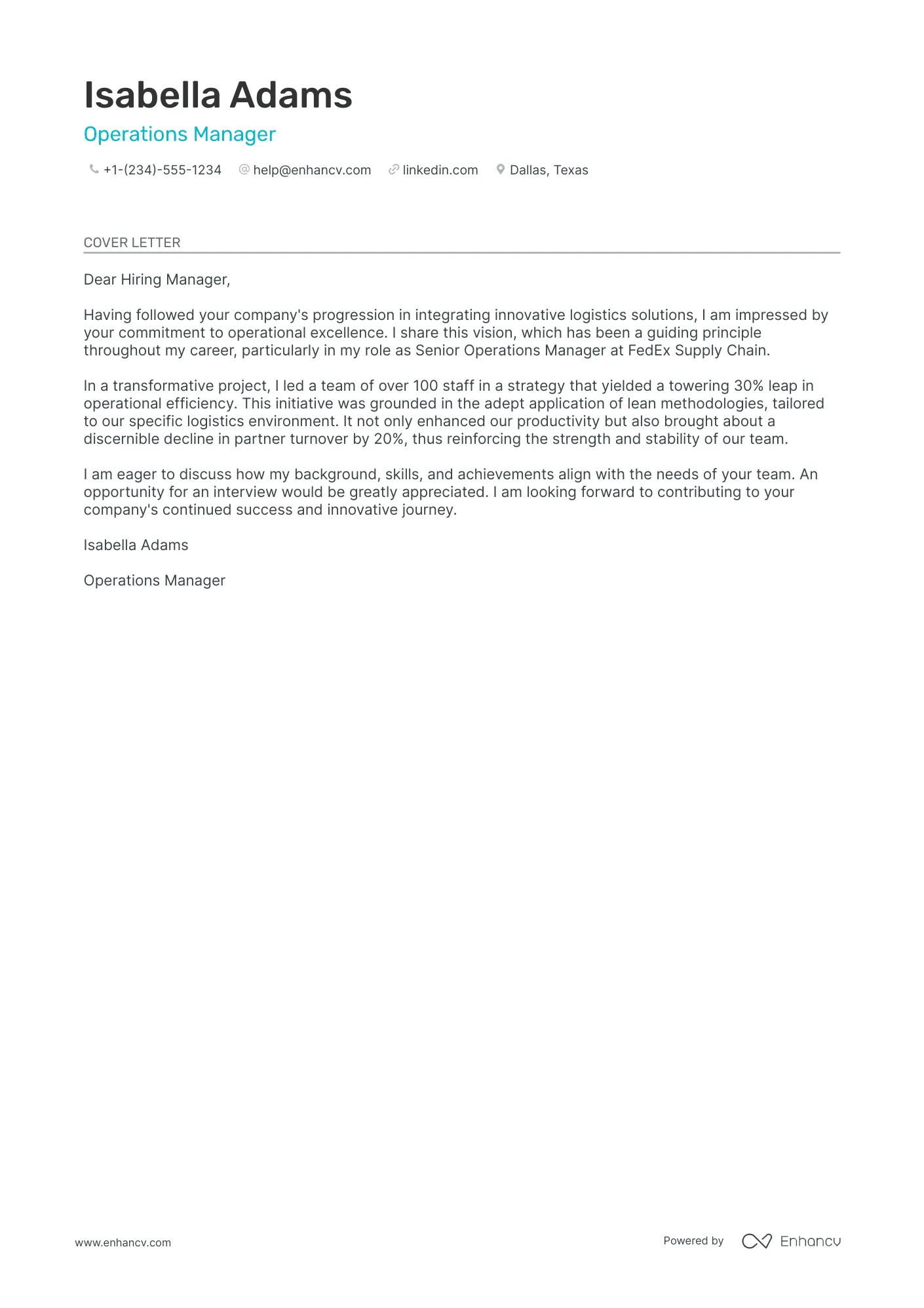Understanding the Transportation Manager Cover Letter
A transportation manager cover letter is a crucial document that accompanies your resume when applying for a transportation manager position. It serves as your first impression, offering you the opportunity to highlight your qualifications, skills, and experiences in a way that a resume alone cannot. This guide provides a comprehensive overview of how to craft a compelling cover letter that effectively showcases your suitability for the role and increases your chances of landing an interview. By following these steps, you can create a persuasive cover letter that sets you apart from other applicants. The cover letter should be tailored to each specific job application, reflecting your unique understanding of the position and the company’s needs.
What is a Transportation Manager?
A transportation manager is a professional responsible for overseeing and coordinating the movement of goods or people. Their duties include planning and managing the entire transportation process, from procurement of vehicles to route optimization and ensuring timely delivery or arrival. They ensure efficiency and cost-effectiveness in the transportation operations. Transportation managers must possess strong organizational, communication, and problem-solving skills, as well as in-depth knowledge of transportation regulations and industry best practices. They often work in various industries, including logistics, supply chain management, manufacturing, and public transit, managing all aspects of transportation operations to meet organizational goals effectively. Their role is essential for businesses that rely on the efficient movement of products or people.
Key Responsibilities of a Transportation Manager
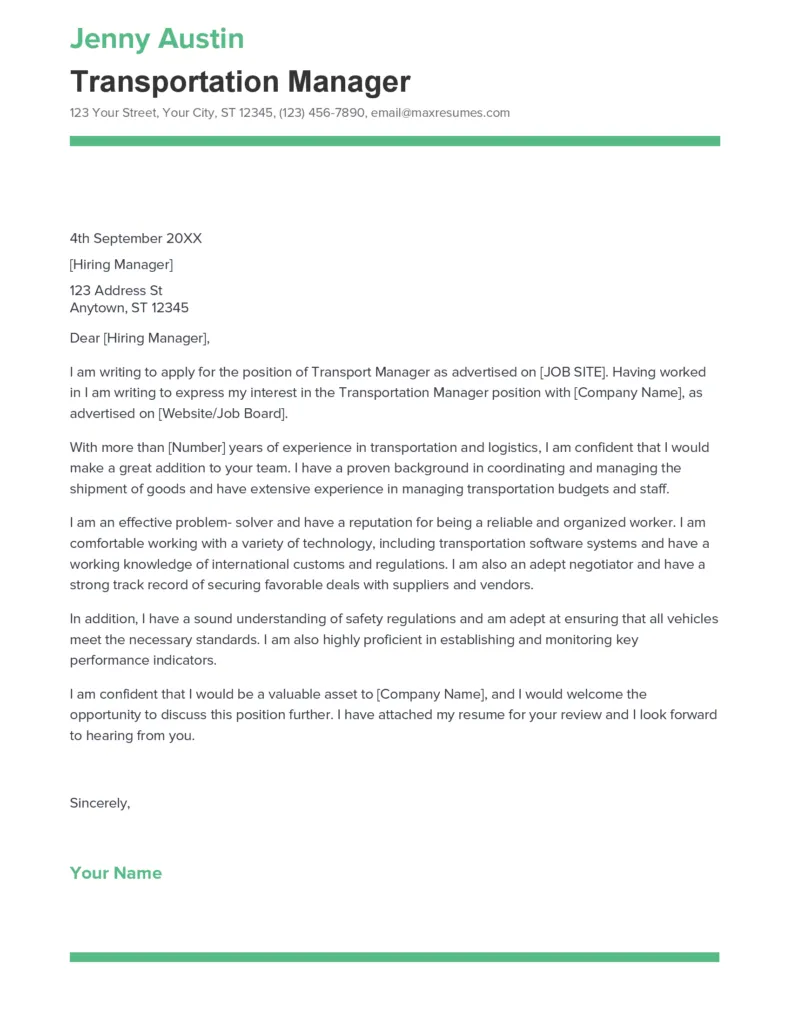
Transportation managers have a broad range of responsibilities that vary depending on the organization and industry. Core responsibilities often include route planning and optimization, fleet management, budget management, and ensuring compliance with all relevant laws and regulations. They are also responsible for negotiating contracts with vendors and carriers, monitoring driver performance, and implementing safety protocols. Additionally, transportation managers often oversee the development and implementation of transportation strategies, ensuring that the organization’s transportation operations align with its overall business goals. Effective communication and collaboration with other departments, such as sales, operations, and customer service, are also critical for successful transportation management. In essence, the role encompasses all aspects of the efficient and cost-effective movement of goods or people.
Why a Cover Letter Matters
A cover letter is more than just a formality; it’s your opportunity to make a strong initial impression. It allows you to showcase your personality, express genuine interest in the role and the company, and elaborate on your skills and experience in a way that a resume cannot. A well-crafted cover letter provides context for your resume, helping the hiring manager understand how your qualifications align with the specific requirements of the job. It also demonstrates your writing skills, attention to detail, and communication abilities, all of which are essential qualities for a transportation manager. The cover letter gives you the chance to explain any gaps in your employment history or highlight any unique experiences that make you a strong candidate. By investing time in a thoughtful cover letter, you significantly increase your chances of securing an interview.
Crafting Your Transportation Manager Cover Letter
Header Section
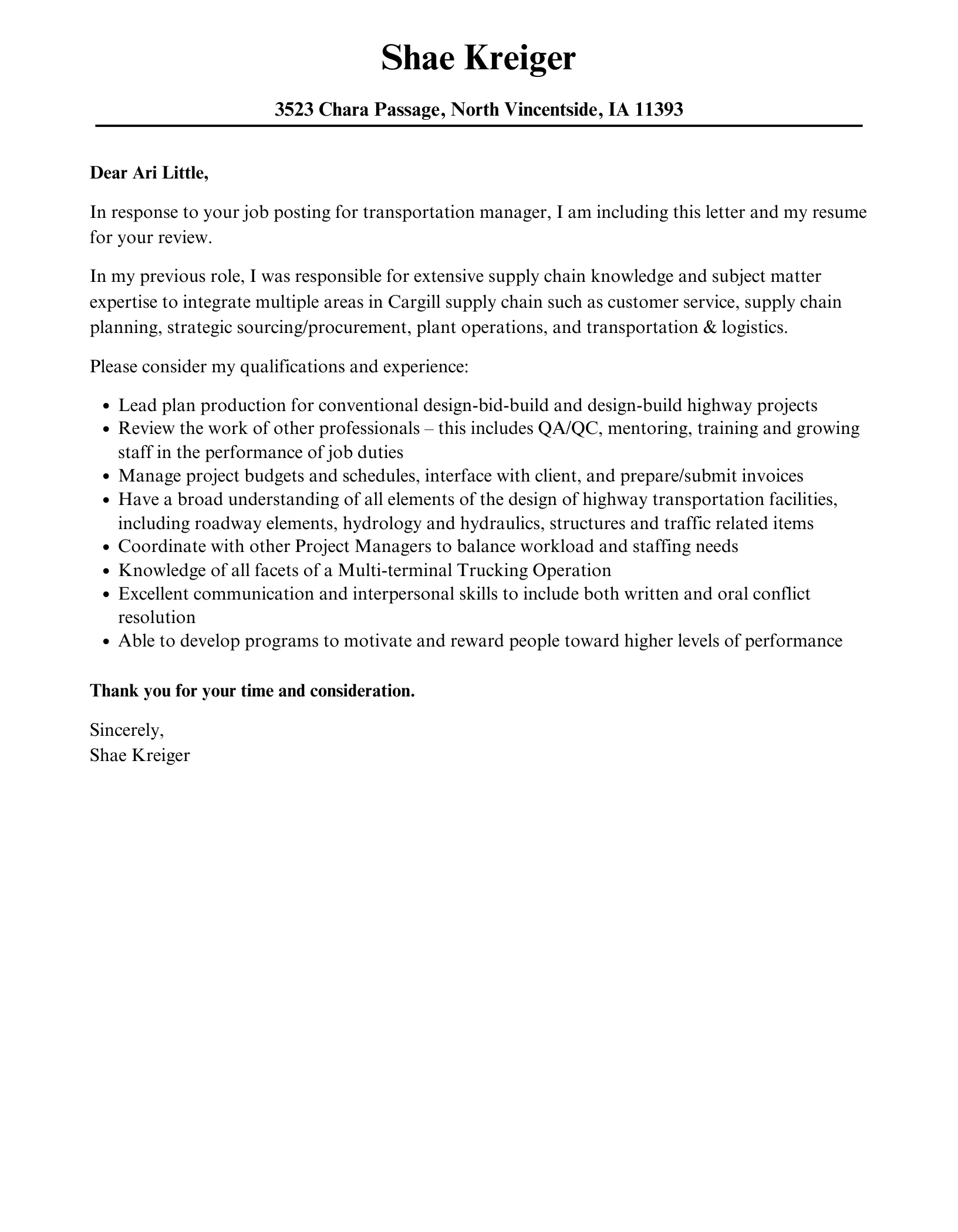
Your cover letter should start with a professional header. This should include your contact information and the date. The header should be formatted neatly and consistently. Using a clear and readable font is essential. The header ensures the hiring manager can easily contact you. This section sets the tone for the rest of your letter. Make sure your contact information is accurate and up-to-date. Using a professional email address is highly recommended.
Applicant Contact Information
Include your full name, phone number, and professional email address. Ensure these are accurate and easily accessible. Consider including a link to your LinkedIn profile. This adds another dimension to your application. It gives the hiring manager a quick way to learn more about your professional background. It’s also important to use a professional-sounding email address.
Date and Recipient Information
Following your contact information, include the date. Then, provide the hiring manager’s name, title, and the company’s address. Always try to find the name of the hiring manager; this shows you’ve done your research. If you can’t find a specific name, use a professional salutation, such as ‘Dear Hiring Manager.’ Accurate recipient information demonstrates your attention to detail and professionalism.
Salutation
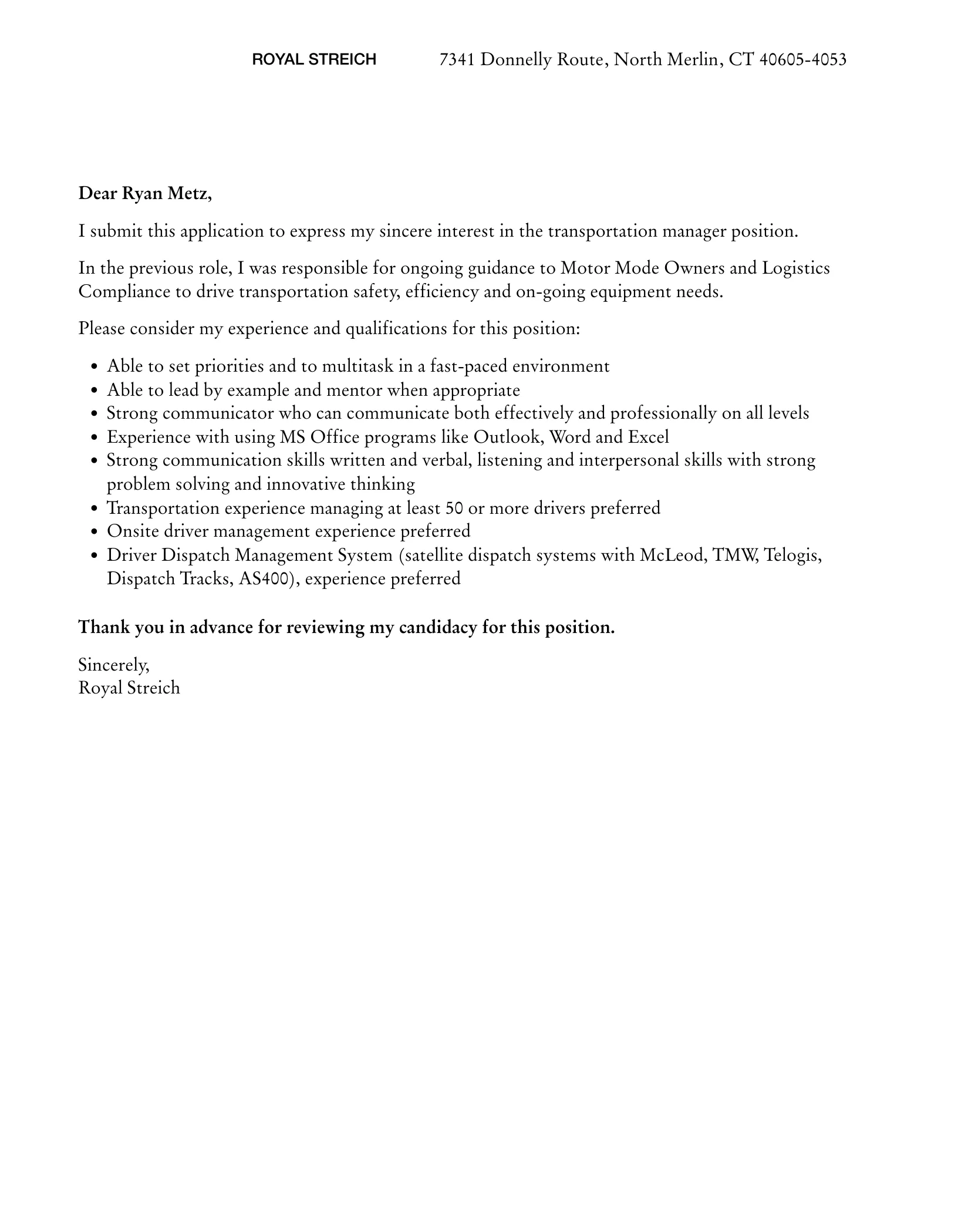
Begin with a professional salutation. ‘Dear Mr./Ms./Mx. [Last Name]’ is best if you know the hiring manager’s name. If not, ‘Dear Hiring Manager’ is appropriate. Avoid generic greetings like ‘To Whom It May Concern,’ which can make your letter feel impersonal. The salutation sets the tone for your cover letter. A personalized salutation shows you’ve taken the time to research the company and the role.
Body Section
First Paragraph Grab Attention
Start with a strong opening statement that grabs the reader’s attention. Express your interest in the position. Briefly mention how you learned about the job opening. This could be through a job board, a company website, or a referral. State why you are a suitable candidate for the role. Show your enthusiasm and highlight a key skill or achievement. Your first paragraph should entice the hiring manager to read the rest of your letter. Keep it concise and compelling to capture their interest immediately.
Highlighting Relevant Skills and Experience

The body of your cover letter is where you showcase your skills and experience. Use the job description as your guide. Mention the specific skills and qualifications that the employer is seeking. Provide examples of how you’ve used those skills in previous roles. Quantify your achievements whenever possible. Use action verbs to describe your accomplishments. Show how you’ve improved efficiency, reduced costs, or increased productivity in previous positions. Demonstrate how your skills align with the requirements of the job.
Quantifiable Achievements
Provide quantifiable results to demonstrate your impact. Instead of saying you ‘improved efficiency,’ specify by how much, such as ‘reduced transportation costs by 15%.’ Use numbers to support your claims. Mention specific projects or initiatives you’ve led. Quantifiable achievements add credibility to your cover letter. They show the hiring manager the value you can bring to their company. Be precise and provide concrete examples of your accomplishments.
Addressing the Employer’s Needs
Show that you understand the company’s needs and challenges. Research the company. Demonstrate how your skills and experience align with their specific requirements. Tailor your cover letter to the company and the specific role. Mention any projects or initiatives that align with the company’s goals. Show how you can solve their problems and contribute to their success. Show you’ve done your homework and are genuinely interested in the company.
Tailoring Your Letter
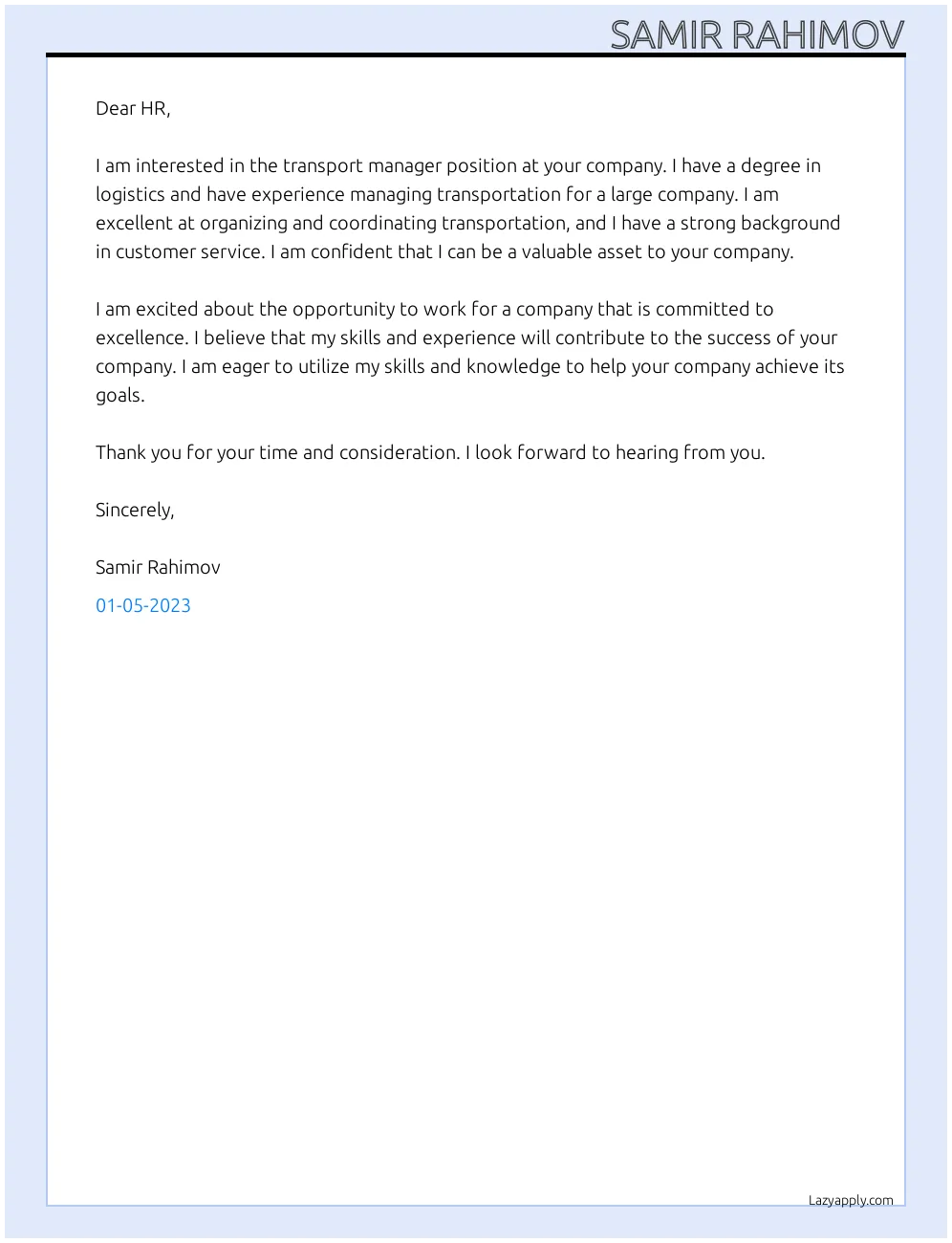
Customize your cover letter for each job application. Use the job description as a template. Highlight the skills and experiences most relevant to the position. Avoid using a generic cover letter. Tailoring shows that you’ve taken the time to understand the role and the company. Mention the company’s values and culture. Demonstrate how you would be a good fit. Customization increases your chances of being noticed and selected for an interview. Always make sure that the letter is tailored to the specific job you are applying for.
Use Keywords
Include keywords from the job description in your cover letter. This is important for Applicant Tracking Systems (ATS). These systems scan your cover letter and resume for relevant keywords. Using the right keywords increases your chances of getting noticed. Make sure you incorporate the keywords naturally. Don’t stuff the letter with keywords. The goal is to demonstrate your understanding of the job and your suitability for the role. Carefully review the job description and incorporate keywords.
Showcase Your Personality
Let your personality shine through your cover letter. Show your enthusiasm for the role. Use a professional and confident tone. Avoid sounding generic or overly formal. Your personality makes you memorable. It can help you stand out from other applicants. Show your passion for transportation management. Show what makes you unique, without being unprofessional.
Closing Section
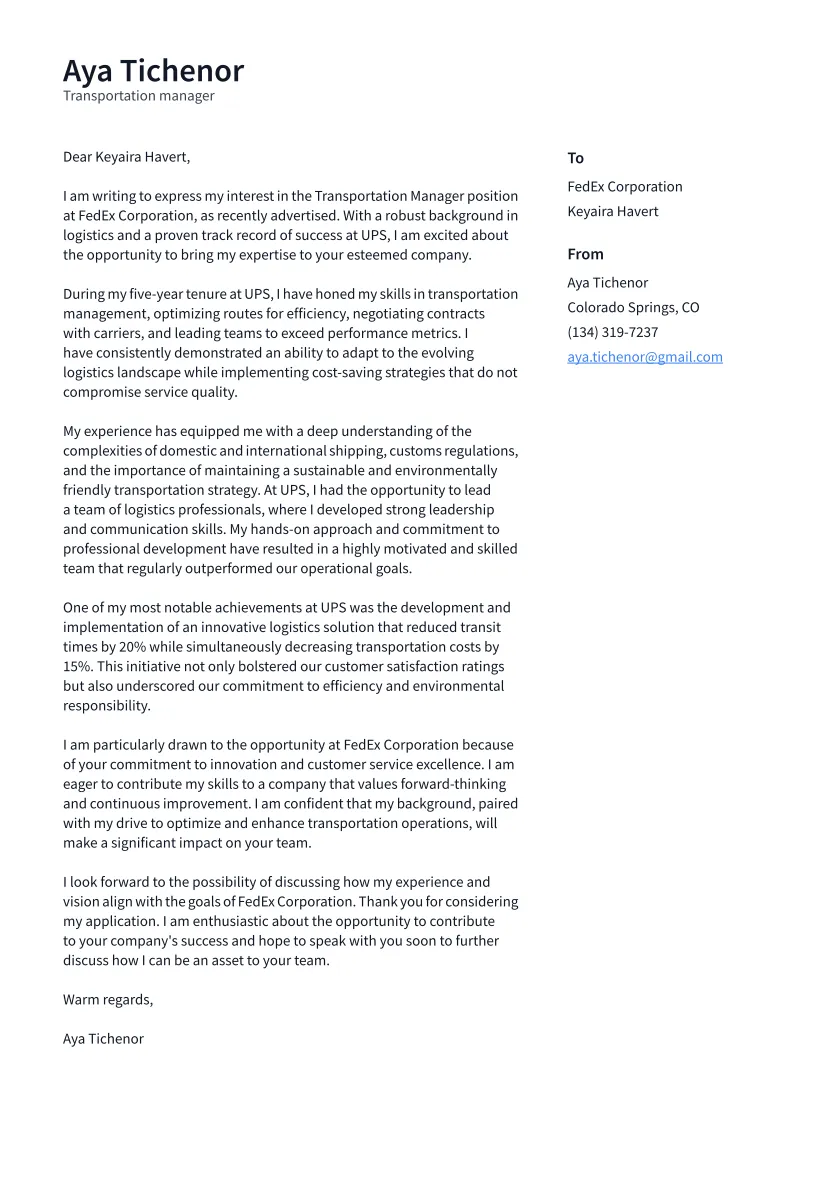
Formal Closing
End your cover letter with a formal closing. Express your appreciation for the hiring manager’s time and consideration. Reiterate your interest in the position. State your availability for an interview. A formal closing demonstrates your professionalism. It leaves a positive final impression. Thank them for considering your application.
Sign-off and Name
Use a professional sign-off, such as ‘Sincerely,’ ‘Best regards,’ or ‘Respectfully.’ Then, type your full name. Leave space for your signature if you’re submitting a printed copy. Ensure a professional and polished finish. Proofread your letter one last time before submitting. A proper sign-off shows respect for the hiring manager. It is a standard part of a professional cover letter.
Proofreading and Formatting
Common Mistakes to Avoid
Avoid common mistakes that can hurt your application. These can immediately disqualify your application. Always thoroughly proofread your cover letter to ensure it is free of errors. Carefully review your document to make sure that the formatting is consistent throughout the letter. Ensure your cover letter presents you in the best possible light.
Lack of Customization
Do not use a generic cover letter for multiple applications. Tailor your cover letter to each job. Generic letters show a lack of interest. Tailoring your letter shows you’re serious about the role. It shows you have taken the time to research the company. Customize the letter to match the specific job description.
Typos and Grammatical Errors
Typos and grammatical errors can undermine your credibility. Proofread your cover letter carefully. Use spell-check and grammar-check tools. Have someone else review your cover letter for you. Errors can make you look unprofessional. They may make the hiring manager question your attention to detail. A polished, error-free cover letter shows you’re serious and professional.
Unprofessional Tone
Maintain a professional tone throughout your cover letter. Avoid slang, informal language, and humor. Be confident, but avoid being arrogant. Use a professional tone that is appropriate for the workplace. Keep your tone clear and concise. An unprofessional tone can make you look immature or unsuitable for the role.
Formatting Issues
Ensure your cover letter has a consistent and clean format. Use a readable font and font size (e.g., Times New Roman, 12pt). Use clear headings and spacing to make your letter easy to read. Avoid excessive use of bolding, italics, or underlining. Consistent formatting helps the hiring manager to quickly and easily digest your information.
Finalizing and Submitting Your Cover Letter
File Format
Save your cover letter in a professional file format, such as PDF. PDF files preserve the formatting and layout of your document. This ensures that your cover letter looks the same on any device. Make sure the file name is clear and professional (e.g., ‘JohnDoe_TransportationManagerCoverLetter.pdf’).
Submission Process
Follow the instructions provided in the job posting. Submit your cover letter and resume together as one file, if possible. Double-check your application before submitting. Ensure that all required documents are attached. Carefully review your application to avoid any last-minute errors. Confirm that you have met all of the application requirements before submitting.
